In three hours, you can see a long movie or drive to New York City or watch a baseball game. You could also, possibly, save a life. There is a three-hour window of opportunity in which a stroke victim will benefit the most from your help: recognizing the symptoms of a stroke and then getting medical attention. This is the key to survival, but also possibly a chance to reverse the damage suffered by the stroke victim. The clock is ticking – now is the time to learn as much about stroke as possible! This is because every 4 minutes someone in the United States dies from a stroke. That makes stroke one of the leading causes of death in America, according to the CDC. Your knowledge and fast action where stroke is concerned is essential to changing those statistics.
A stroke basically is the brain under attack. Consider this – the brain is the epicenter of all activities of the body. It controls everything from thoughts and feelings to making sure the heart pumps blood and the lungs breathe, so it is vital to protect it. There are two types of stroke, and both are life-threatening. The majority of strokes are known as ischemic. This means that there is a blockage in an artery of the brain, usually caused by a blood clot. The less common stroke is known as hemorrhagic. This means that a blood vessel in the brain has broken open and is bleeding directly into the brain. Both types of stroke mean that certain areas of the brain are not getting oxygen, which is vital to brain cells. Within minutes after the oxygen is cut off, brain cells are damaged and can start to die.
Anyone, at any age, can have a stroke. The risk for having a stroke increases as we age but don’t assume you are safe if you are young. In 2009, the CDC states that more than a third of all stroke victims were under the age of 65. The CDC also reports that African Americans, Native Americans and Alaskan Natives are at greatest risk of stroke, followed by Hispanics, then Caucasians. Having high blood pressure, high cholesterol, being obese and/or smoking raises the stakes even more, regardless of age or race.
Sometimes the symptoms of a stroke are subtle at first. Sometimes these warning signs are misinterpreted as other, less serious issues. According to the CDC, the symptoms that are the most common signs of a stroke come on suddenly and include:
• Numbness/weakness in the face, arm or leg, especially just on one side of the body
• Confusion with language – slurred words, unable to find words, trouble understanding speech
• Blurry vision
• Trouble walking – particularly dizziness, unusual loss of balance/coordination
• Severe onset of headache
Your job? Act F.A.S.T. if you suspect a stroke. The National Stroke Association urges everyone to learn these steps:

If you decide that yes, this is a stroke, don’t hesitate – call 9-1-1 (even if the stroke victim is not in agreement with you). Make sure you record the time symptoms started and relay that information to the first responders.
Knowing the best defense is a good offense, why not work to prevent a stroke in the first place? What that means, is that it is time to make some changes in your life. Quitting smoking is on the top of the list of lifestyle changes that can help prevent stroke. Those who are overweight or obese are urged to lose those excess pounds and keep them off. Don’t forget to throw on walking shoes or hop on a bike or take up zumba, since regular physical activity also helps. Last, but not least, a healthy eating plan is highly encouraged. A recent study in the May 2014 journal Stroke showed that risk of stroke dropped 32 percent by eating at least one fruit a day and by 11 percent by eating one serving of veggies daily. The report went on to state that certain fruit and veggies were specifically identified as beneficial such as apples, green leafy vegetables (think spinach, kale), citrus, pears, berries, root vegetables (such as beets, carrots), onions, leeks and garlic. And it isn’t just produce that helps- it is also suggested that people eat high fiber whole grains, choose heart healthy fats (such as fish, olive oil, nuts & seeds) and lower the amount of sodium in their foods.
It took 160 minutes to write this article. We know that every 4 minutes, someone dies from a stroke, meaning 40 people may have died during this time. Don’t let this happen to someone you love… act F.A.S.T.
Jennifer Giffune, R.D., L.D.N. is a freelance author, professional speaker and nutrition counselor. She currently is providing nutrition counseling services for Hampden County Physician Associates at their offices in Westfield, Southwick and West Springfield. If you would like to schedule a counseling session with Jennifer, please call (413) 569- 2257.

